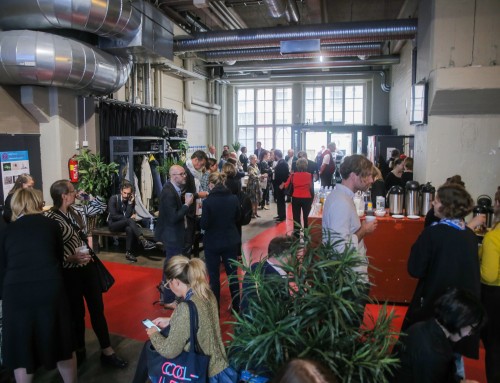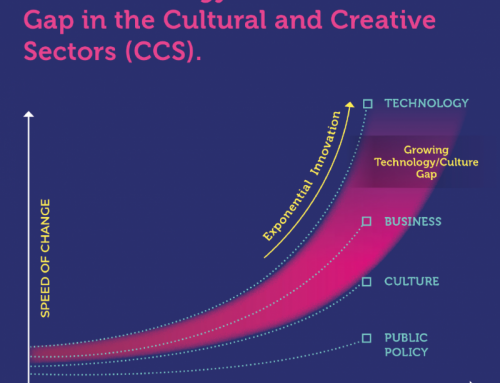A Plea for Potentials and Priorities of Cultural and Creative Sectors in the Research Framework Programme 9
The previous 8th European Research Framework Program Horizon 2020 (FP 8) focused on societal challenges and priorities. All the successful impacts of FP 8 do not make up one structural disadvantage: ‘spill-overs’ did not gain interest adequate to its potential, while many innovations result from cross-overs between disciplines. The Cultural and Creative Sectors (CCS) have proven to be a vehicle to stimulate these cross-overs.
Especially at the interface of cultural and creative sectors and digital technologies, both break-through and incremental innovations can effectively be supported. The range of possible applications is manyfold, for instance in health & wellbeing, mobility, green energy and climate change. The NICE Award[1] showcases best practices of such spillover innovations since 2014. The Digital R&D Fund for the Arts by NESTA and the Arts Council England[2] is a role model for funding instruments to mainstream innovation at crossover of CCS and digital technology. There is a need to support such spill-overs at a European level as well.
Funding cross-innovation in its social, not just technology, dimension is also paramount to an open society in Europe: cultural stakeholders in Europe have extensive practice and knowledge of social innovations, but they are too often limited to local boundaries. Mainstreaming local innovations trans-nationally and trans-culturally would support quick concrete problem-solving in Europe, especially for the unemployed youth. It would also support an open and diverse Europe politically. The National Alliance for Arts, Health and Wellbeing is such an example[3].
A new priority
The European Creative Business Network[4] (ECBN) proposes to make the cultural and creative sectors a priority in FP 9. The FP 8 model has enabled first and great steps to promote CCS. In the future, however, it needs to take multiple dimensions to unleash the full value of CCS – of which cross-innovation is just one.
The economic size and societal importance of CCS with 12 million full-time jobs, which amounts to 7.5 % of the EU’s work force, and approximately EUR 509 billion in value added to GDP, can only fully support the future of Europe with a new strategic priority within Research Framework Programme 9 (FP 9).
The new Research FP 9 Strategy must include at least a priority for cross-innovation of CCS. Whether this is by integrating CCS in the existing challenges, or creating a new challenge, is up to policy makers and the EU administration to develop. Given the relevance of startups and SMEs in CCS for urban development and industrial leadership, the benefits of CCS could also be mainstreamed in Europe through an own challenge: how to foster the disruptive innovation by CCS – hardly within an old economy challenge? How to find new technologies driven by cultural creative content – hardly with a technology challenge?
Also calls are in most of the cases too abstract and too far away from the markets of the creative industries. Continuously open calls with cut-off dates should be given priority over singular calls in order to provide for continuity. Long-term programs would allow for a better planning from the perspective of creative companies.
Size matters
Given the innovation intensity in cultural and creative sectors, it is adequate to invest at least 1 Billion Euro in Research and Development, that is 2% of its GDP of 509 Billion Euro. In comparison: The German CCS invest in innovation approx. 4,8 Billion Euro each year as the CCS Monitoring Report 2017 of the German Federal Ministry for Economy and Energy proofs.[5] This equals 4,85% of the CCS value added of 98,8 Billion Euro in 2016. Is the European Union able to live up to the sectors requirements? Obviously the budget of FP 9 is large enough to invest in 1 Billion Euro CCS, but are insight and vision great enough?
Christian Ehler, MEP, Co-Chair of the Intergroup for Cultural Creative Sectors and Member of the Committee on Industry, Research and Energy, has been driving the agenda for creative industries (see Report of EP on Coherent Policy for cultural and creative industries, Nov 2016) and comments the current discussions on FP 9 in May 2018:
“CCIs are at the heart of the European industry. They have to be able to profit from the benefits of research like any other industry. CCIs are breakthroughs, potentials and full of surprises for new ideas. They will be the most promising addition to the new research framework program (Horizon Europe) to be made.”
Today spillover effects and cross-innovation of CCS are the focus, but one must not forget the simple basis of the CCS: it is content production. As much as technology sectors need investments in new materials, CCS needs investment in content. Content – especially as big-data platforms thrive on content – is the conveyor belt of the 21st-century.
Concluding, CCS add substantial value to both Europe’s economy and society in two directions: direct economic growth, next to the large-scale spill-over effects. The new FP 9 is an opportunity for Europe to break the vicious circle of discussions about lacking evidence or inadequate evaluation, but instead invest in CCS as a driver for innovation. Around 12 million employees in CCS across Europe are awaiting policy action!
Frits Grotenhuis
Bernd Fesel
May 2018
[1] https://www.e-c-c-e.de/nice-award-2017.html
[2] https://www.nesta.org.uk/project/digital-rd-fund-arts
[3] http://www.artshealthandwellbeing.org.uk/resources/research
[5] http://www.kultur-kreativ-wirtschaft.de/KUK/Redaktion/DE/Publikationen/2017/monitoring-wirtschaftliche-eckdaten-kuk-2017.html









Leave A Comment